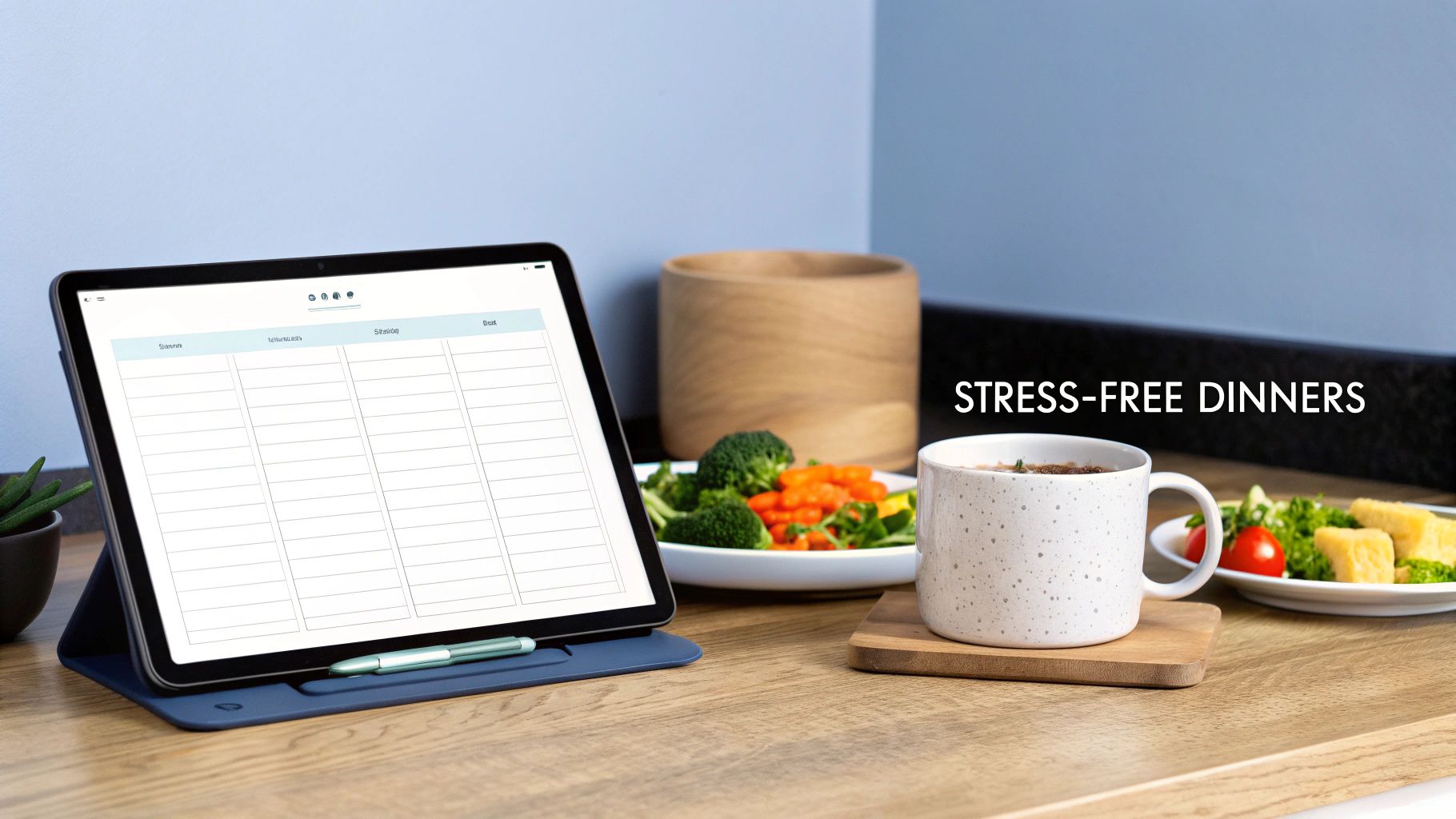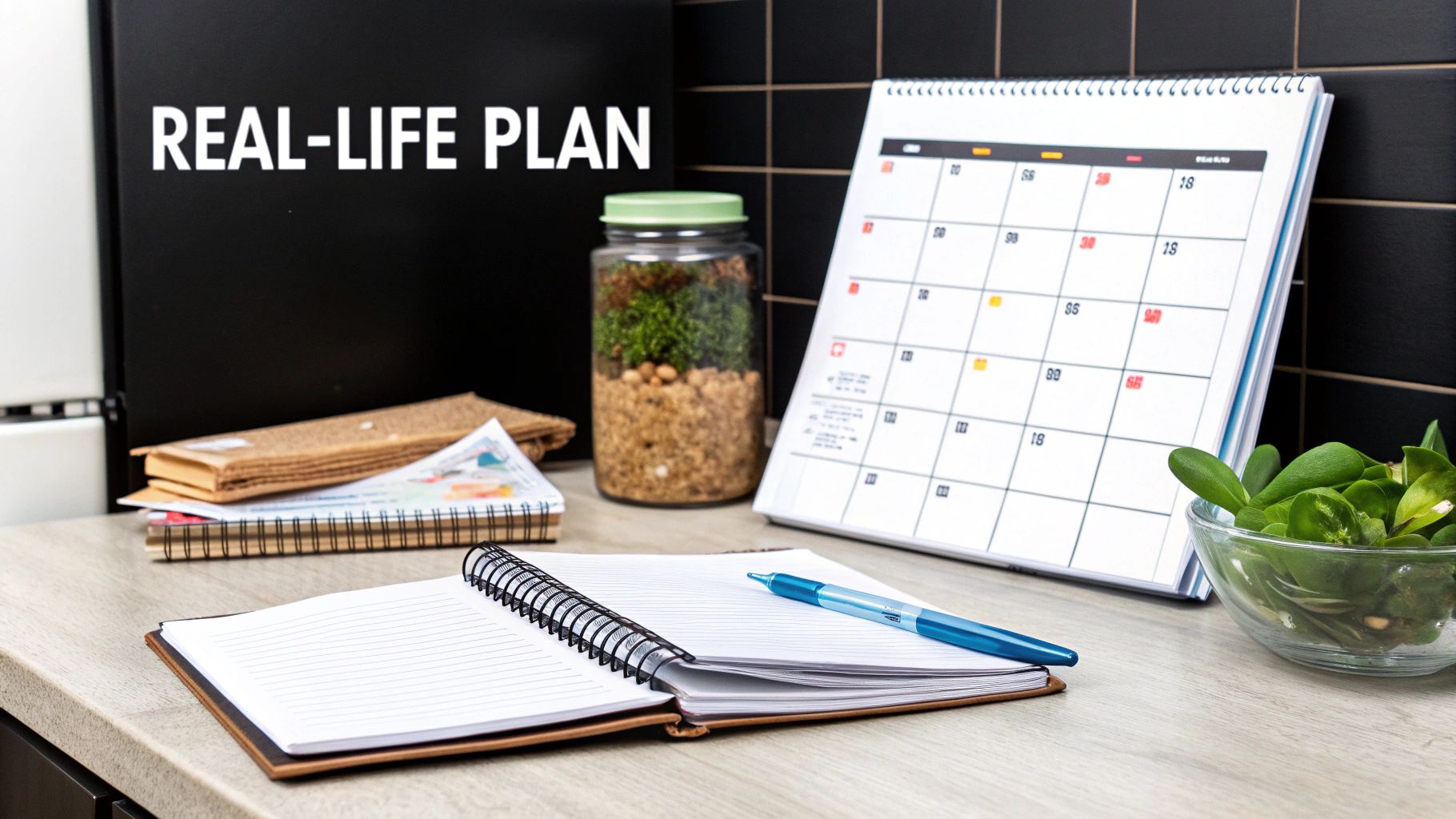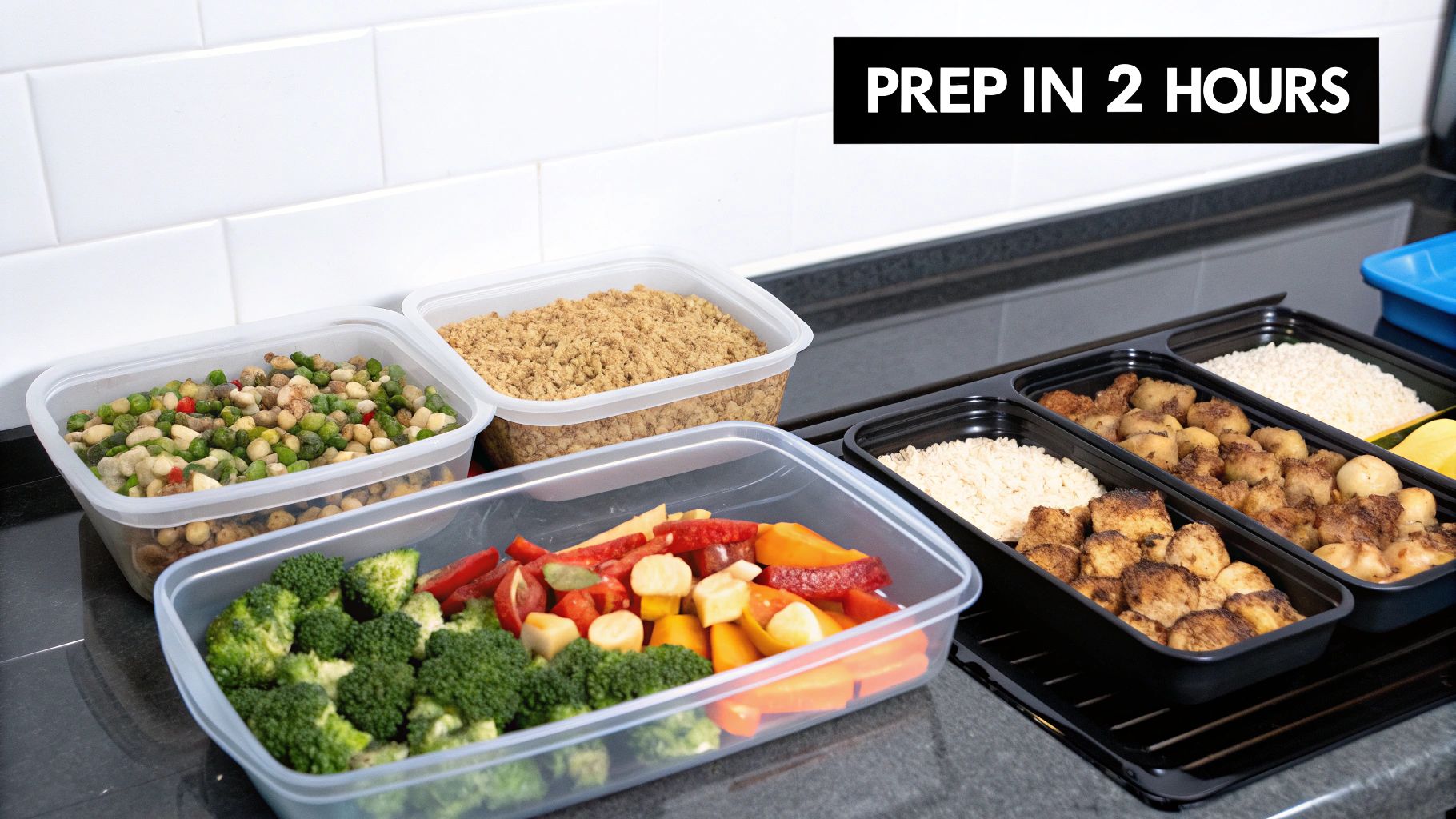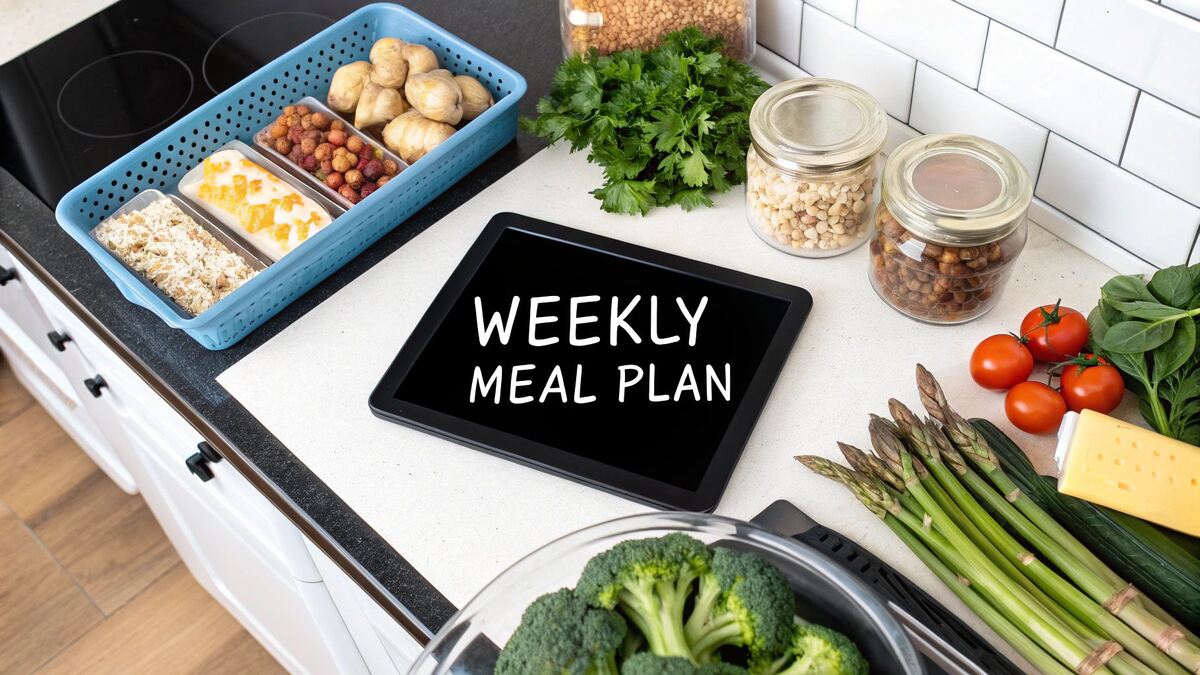Vegetarian Weekly Meal Planner That Works
A solid vegetarian weekly meal planner is your ticket to reclaiming time, slashing stress, and making healthy eating your default. Think of it as the simple habit that puts an end to frantic, last-minute grocery runs, cuts down on food waste, and guarantees your meals are as delicious as they are nutritious.
Why Meal Planning Is Your Secret Weapon

Let's be real—the daily "what's for dinner?" scramble is exhausting. It's a question that too often leads to the same old boring meals or, worse, another expensive takeout order. A well-thought-out meal plan is your roadmap for the week, wiping out decision fatigue and turning cooking from a chore into something you can actually look forward to.
This isn't just a personal hack; it's part of a huge global shift. The market for veggie-centric meals is set to rocket to USD 9,712 million by 2035. That's a massive indicator that more and more people are seeing the light and looking for smart, structured ways to eat plant-based.
It's More Than Just Being Organized
A vegetarian weekly meal planner does so much more than just line up your recipes. It genuinely changes your relationship with food for the better.
- You'll Save Money: When you plan your meals, you buy exactly what you need. No more impulse buys or forgotten produce rotting in the back of the fridge. This kind of focused shopping can seriously trim your grocery bill.
- You'll Eat Better: Planning gives you total control over what you're eating. You can intentionally build a balanced diet, making sure you hit your protein targets, get plenty of fiber, and eat a true rainbow of veggies throughout the week.
- You'll Get Your Time Back: Imagine all the mental energy you'll save. A plan cuts out the daily meal deliberation and the extra trips to the store, giving you back precious hours every week.
A great meal plan isn't about restriction; it's about freedom. It’s freedom from stress, freedom to get creative in the kitchen, and freedom to nourish your body with intention.
Ultimately, this proactive approach is what makes a healthy, plant-based lifestyle stick. You stop reacting to hunger with whatever is fastest and start building a foundation of consistently delicious, nourishing meals. If you want to dive right in, our powerful weekly meal planner at https://ai-mealplan.com/weekly-meal-planner is the perfect place to start. It’s the first real step toward a calmer, more satisfying kitchen routine.
Building a Plan That Fits Your Real Life

Let's be honest: a meal plan that doesn't fit your actual life is just a pretty piece of paper. Before you even think about recipes, the first step is to ground your vegetarian weekly meal planner in reality. That means taking a good, hard look at your schedule, your budget, and what you genuinely like to eat.
This is where most people get tripped up. It’s no surprise that while surveys show 68% of people want to eat more plant-based foods, only about 20% actually manage to do it consistently. The bridge between wanting and doing? A plan that’s built for your life.
A realistic plan is one you can stick to, even when life gets chaotic. It's designed to work around your schedule, not the other way around.
Assess Your Real-World Constraints
First, ask yourself a few honest questions about a typical week. How many nights do you really have the time and energy to cook a full meal from scratch? Are there evenings where a 15-minute "pantry meal" is the best you can hope for?
- Time Audit: Pull up your calendar. Are Tuesdays a late night at the office? Is Thursday jam-packed with the kids' activities? Get real about your available cooking time each day.
- Budget Check: Set a weekly food budget you can actually live with. This number will be your guide, steering you toward affordable staples like beans, lentils, and whatever produce is in season.
- Kitchen Inventory: Take a quick peek in your pantry, fridge, and freezer. Knowing what's on hand stops you from buying things you already have and can spark ideas for using up ingredients.
Your perfect meal plan doesn’t need to be fancy or gourmet. It just needs to work for you. Success isn't cooking seven elaborate new recipes; it's getting through the week feeling prepared and nourished.
Aligning Goals with Your Lifestyle
With that reality check done, now you can think about your goals. Are you trying to sneak in more leafy greens? Boost your protein intake? Or maybe just try one new recipe a week? Knowing your "why" gives your plan a purpose.
For instance, if more protein is the goal, you’ll want to build your week around meals with lentils, tofu, or tempeh. If you're always short on time, a smart tool like our meal plan generator can be a lifesaver, instantly finding quick recipes that fit your criteria. The whole point is to connect your nutritional goals with the time and resources you actually have.
If you really want to get organized, you could even build a personal second brain to keep all your favorite recipes, shopping lists, and ideas in one place. This kind of thinking turns your meal planner from a chore into a personalized tool, setting you up for a week of stress-free, delicious eating.
Curating Your Go-To Recipe Collection
Endless scrolling through recipe blogs can feel just as draining as staring into an empty fridge. The real secret to a sustainable meal plan isn't about finding new recipes every single week—it's about stopping the hunt and starting a collection.
Building your own curated library of trusted, go-to recipes is probably the single best thing you can do to simplify your entire cooking routine. This collection becomes your personal menu, full of meals you’ve already tested, know your family enjoys, and that actually fit your real-world schedule. No more guessing games or last-minute recipe fails on a busy Tuesday night.
Embrace Themed Nights to Simplify Decisions
One of the most effective ways I've found to beat decision fatigue is to assign a loose theme to each night of the week. This simple trick provides just enough structure to make planning feel effortless while still leaving plenty of room for creativity. It turns the dreaded "what's for dinner?" question into a much more focused choice.
Think of it as creating helpful categories for your brain. Instead of staring at a blank slate, you’re just deciding which pasta dish or what kind of taco filling sounds good.
Here are a few classic theme ideas to get you started:
- Meatless Monday: A great way to kick off the week with something hearty and plant-forward.
- Taco Tuesday: Super fun and customizable. Think black bean tacos, spicy lentil fillings, or roasted sweet potato and cauliflower creations.
- Stir-fry Wednesday: Perfect for using up whatever veggies are left in the crisper drawer. A quick teriyaki or peanut sauce brings it all together.
- Pasta Thursday: Who doesn't love pasta night? You can go with a simple marinara, a creamy veggie-packed alfredo, or a fresh pesto.
- Pizza Friday: The perfect casual end to the week. Use store-bought dough or make your own and let everyone add their own toppings.
The point of a themed night isn't to be rigid; it's to provide a starting point. It's a mental shortcut that dramatically speeds up the process of filling out your weekly plan.
To give you a better idea of how this looks in practice, here's a sample framework.
Sample Themed Weekly Vegetarian Menu Structure
This table provides a simple framework for organizing your week with themed dinner ideas to simplify recipe selection and add variety.
| Day of the Week | Dinner Theme Idea | Example Recipe |
|---|---|---|
| Monday | Hearty Soups & Stews | Lentil and Vegetable Stew |
| Tuesday | Global Flavors (Tacos) | Black Bean & Corn Tacos |
| Wednesday | Quick Pasta | Lemon Garlic Pasta with Spinach |
| Thursday | One-Pan Roasts | Roasted Root Vegetables with Tofu |
| Friday | DIY Pizza Night | Veggie Supreme Pizza |
| Saturday | New Recipe Adventure | Homemade Veggie Burgers |
| Sunday | Comfort Classics | Mushroom Shepherd's Pie |
Using a structure like this gives your week a predictable rhythm, making the whole planning process feel much less like a chore.
Select Recipes with Ingredient Overlap
A truly efficient meal plan is one where the recipes work together. As you pick out your meals, start looking for ways to use the same ingredients in multiple dishes. This is an absolute game-changer for cutting down on food waste and making your grocery list a whole lot shorter.
For example, that big bag of spinach you buy can go into a quiche over the weekend, get tossed into a pasta dish on Thursday, and a few handfuls can even be thrown into your morning smoothie. A bunch of cilantro can garnish your tacos on Tuesday and also be a key ingredient in a lentil soup later in the week.
Balance Quick Weeknight Meals with Weekend Cooking
Let's be realistic: your energy and available time are not the same on a Wednesday evening as they are on a Saturday afternoon. A successful meal plan accounts for this. You need a good balance of quick, low-effort dinners for those busy weeknights and more involved cooking projects for the weekend.
- Weeknights (Mon-Thurs): I always aim for recipes that take 30 minutes or less to get on the table. Think one-pan meals, quick stir-fries, or simple pasta dishes.
- Weekends (Fri-Sun): This is your time to shine! Try that new recipe you bookmarked, batch-cook some grains for the week ahead, or make a more elaborate dish like a veggie lasagna.
This approach keeps you from getting burned out and makes cooking feel genuinely manageable. To get a head start with some fantastic recipes that fit this model, you can explore our full library of vegetarian meal plans. You'll find a great mix of quick and satisfying options to start building your collection.
Creating a Smarter Shopping List

Alright, you've picked out your recipes for the week. Now comes the part that can make or break your plan: the shopping list. Think of it less as a simple list and more as your blueprint for success. A well-crafted list is a powerful tool that saves you time, slashes food waste, and keeps your grocery budget from spiraling out of control.
It’s all about moving from a random scribble on a notepad to an organized, intentional plan. This little mindset shift is what turns a frantic dash through the grocery store into a calm, efficient mission. No more zig-zagging back to the produce section for a forgotten onion or getting tempted by the snack aisle. You’ll be in and out with exactly what you need.
From Random List to Store Map
I learned this trick years ago, and it's a game-changer: organize your shopping list to match the layout of your grocery store. Instead of one long, chaotic list, group everything by department. It sounds simple, but it makes a huge difference in how quickly you can get your shopping done.
Try breaking your list into these logical categories:
- Produce: All your fresh stuff—onions, spinach, bell peppers, sweet potatoes.
- Pantry & Dry Goods: Canned beans and tomatoes, grains like quinoa or pasta, spices, oils.
- Refrigerated: Tofu, tempeh, plant-based milks, yogurt, and cheese.
- Frozen: Berries for smoothies, frozen veggies, or maybe some veggie burgers for a quick meal.
When you structure your list this way, you can move through the store in a single, logical loop. It’s a simple hack that makes the whole experience faster and way less stressful.
The All-Important Pantry Check
Before you even grab your keys, take a minute to scan what you already have. This is a non-negotiable step for me. It stops you from buying a third jar of cumin when you’ve got two hiding behind the flour. A quick peek in your pantry, fridge, and freezer ensures you’re only buying what you actually need.
This habit is a double-win: it saves money and drastically cuts down on food waste. For those looking to really dial in their budget, you can find great info on tracking pantry items and coupons to manage your stock and maximize savings.
A well-stocked pantry is the foundation of any great vegetarian weekly meal planner. Having the essentials on hand means you’re always prepared to whip up a simple, satisfying meal at a moment’s notice.
Building Your Vegetarian Pantry Foundation
Certain ingredients are the unsung heroes of vegetarian cooking. Keeping these shelf-stable items on hand makes your weekly meal prep a breeze and gives you the flexibility to swap a recipe on the fly if needed.
Your Essential Pantry Checklist:
- Legumes: Canned or dried lentils, chickpeas, and black beans are your protein workhorses.
- Grains: Brown rice, quinoa, oats, and whole-wheat pasta for fiber and complex carbs.
- Canned Goods: Diced tomatoes, coconut milk, and vegetable broth are the versatile bases for countless soups, curries, and sauces.
- Healthy Fats: Good olive oil, nuts, seeds (like chia and flax), and nut butters add incredible flavor and nutrients.
- Flavor Boosters: Onions, garlic, soy sauce, nutritional yeast, and a solid collection of dried herbs and spices are absolutely essential for making your food taste amazing.
Once you have these staples stocked, your weekly shopping trips become much quicker and more focused. You'll mostly just need to pick up fresh produce and a few key refrigerated items.
Making Weekend Meal Prep Work for You

Okay, you’ve picked your recipes and survived the grocery store. Now for the step that truly makes your vegetarian weekly meal planner a game-changer: the prep session.
Let's get one thing straight. This isn't about losing your entire Sunday to the kitchen. The goal is to invest a short, focused burst of time now to make your week infinitely easier.
Honestly, a strategic two-hour session on a Saturday or Sunday can be the difference between a chaotic Tuesday night takeaway and a delicious, home-cooked meal ready in minutes. You’re simply front-loading the effort so your future self can thank you later. It’s a small investment that pays off big in time and sanity.
Your Two-Hour Prep Blueprint
The secret to efficient prep is thinking in components, not in complete meals. Forget trying to cook five different dinners from scratch. Instead, you're creating the building blocks that you can mix and match across multiple recipes. This approach keeps things flexible and drastically cuts down your daily cooking time.
Here's a tried-and-true game plan for a two-hour session:
- Roast a Big Tray of Veggies: This is my absolute number one tip. Get a big sheet pan and toss on some broccoli, bell peppers, sweet potatoes, and onions with olive oil and your favorite seasonings. Roast them until they're tender and slightly caramelized. You can throw these into salads, grain bowls, wraps, or pasta all week.
- Batch-Cook a Grain: While the veggies are in the oven, get a pot of quinoa, brown rice, or farro going on the stove. Having a cooked grain on hand is the foundation for so many quick, satisfying vegetarian meals.
- Wash and Chop Produce: Let's face it, this is the boring part you'll be so glad is already done. Wash your lettuce, chop your onions and garlic, and dice any other raw veggies your recipes need. Store everything in airtight containers.
- Prepare a Protein: Press and cube a block of tofu, simmer a batch of lentils, or hard-boil half a dozen eggs. With a protein source ready to go, assembling a balanced meal becomes a simple grab-and-go operation.
- Whip Up a Sauce or Dressing: A homemade vinaigrette or a quick peanut sauce takes five minutes but makes everything taste a million times better. Just shake it up in a jar and keep it in the fridge.
Meal prep isn't about a fridge full of identical, pre-portioned containers. It’s about creating an arsenal of ready-to-use ingredients that make cooking feel less like a chore and more like a simple assembly job.
Smart Prep for Maximum Impact
To really get the most out of your time, think about what you can do at the same time. Your oven, stovetop, and cutting board can all be working in concert.
Here’s how I streamline it:
- Oven on First: The moment I walk into the kitchen, I preheat the oven. Roasting veggies usually takes the longest, so I get them in right away.
- Stove Next: While the oven is heating up and the veggies are roasting, I get my grains cooking on the stovetop.
- Chop While You Wait: All that cooking time is perfect for getting through the chopping and dicing.
This kind of multitasking means you’re always making progress. A simple workflow turns what could feel like a huge task into a manageable—and dare I say, relaxing—Sunday afternoon ritual. This is the engine that makes your meal plan a success, ensuring you actually stick to it, even on the busiest days.
Got Questions? Let's Troubleshoot Common Meal Planning Hiccups
Even with the best of intentions, sticking to a new meal plan can bring up a few questions. When you're just starting out with a vegetarian weekly meal planner, it's normal to hit a few snags, whether it's worrying about nutrients or dealing with a picky eater at the table. Let’s walk through some of the most common challenges I hear about and how to solve them.
"Am I Getting Enough Protein?"
This is, without a doubt, the number one question. New vegetarians often worry they won't feel full or have enough energy. The secret isn't obsessing over numbers but simply being intentional about including a good protein source in every meal.
It's easier than it sounds. Small tweaks make a big impact.
- Breakfast: Are you having oatmeal? Throw in a scoop of protein powder or a handful of walnuts. Smoothie? Add some hemp seeds or Greek yogurt.
- Lunch: A can of chickpeas or lentils can instantly upgrade a simple salad or soup, making it a genuinely filling midday meal.
- Dinner: Think about building your main dish around a protein powerhouse like tofu, tempeh, or a rich, hearty bean chili.
When you make this a habit, you'll find you're easily meeting your protein needs without even thinking about it.
"How Do I Keep Things From Getting Boring?"
Ah, recipe fatigue. We've all been there—the feeling that if you have to eat lentil soup one more time, you'll scream. The key to a meal plan you'll actually stick with is variety, but that doesn't mean you need a million different recipes.
It’s all about rotating your core ingredients and playing with different flavor profiles. If you had a taco bowl with Mexican-spiced black beans on Tuesday, try a Mediterranean-inspired chickpea salad later in the week.
The goal isn't to find a thousand recipes. It's about learning how to use a few dozen core ingredients in a thousand different ways. A simple can of chickpeas can become hummus, a crispy snack, a curry, or a salad topper.
"What If I'm Cooking for Picky Eaters?"
This is a big one. Juggling different tastes in one household can feel like an impossible task. My best advice? Stop trying to cook separate meals and embrace deconstructed or customizable dinners. It puts everyone in charge of their own plate.
Taco night is the classic example for a reason—it works! Set up a build-your-own bar with all the fixings:
- Seasoned black beans or lentils (the protein base)
- Shredded lettuce, diced tomatoes, and corn
- Salsa, guacamole, and a plant-based sour cream
- Shredded cheese (dairy or a dairy-free alternative)
- Sautéed peppers and onions
Everyone gets to build their own perfect taco, and you only had to do one set of prep. This same idea is a lifesaver for grain bowls, pasta bars, and even personal pizzas. It keeps the cook sane and the whole table happy.
Ready to stop guessing and start planning? Let AI Meal Planner build a personalized, delicious vegetarian meal plan just for you. Take control of your meals and discover how easy healthy eating can be at https://ai-mealplan.com.
AI-powered nutrition
Get Your Personalized Meal Plan
AI creates the perfect meals for your goals, lifestyle, and taste.
Start Your Journej
